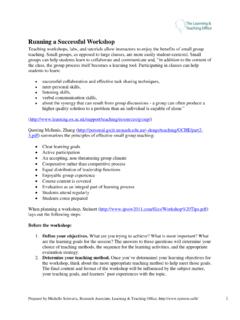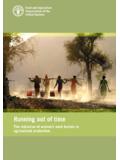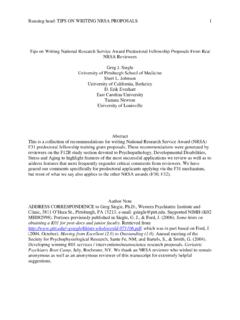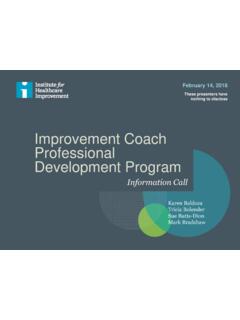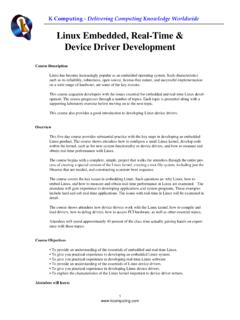Transcription of LEARNING FROM ERROR - who.int
1 Patient Safety WorkshopLEARNING FROM ERRORWHO/IER/ World Health Organization 2008 All rights reserved. Publications of the World Health Organizationcan be obtained from WHO Press, World Health Organization, 20 Avenue Appia, 1211 Geneva 27, Switzerland (tel.: +41 22 791 3264;fax: +41 22 791 4857; e-mail: Requests forpermission to reproduce or translate WHO publications - whetherfor sale or for noncommercial distribution - should be addressed toWHO Press, at the above address (fax: +41 22 791 4806; The designations employed and the presentation of the materialin this publication do not imply the expression of any opinionwhatsoever on the part of the World Health Organizationconcerning the legal status of any country, territory, city or area orof its authorities, or concerning the delimitation of its frontiers orboundaries. Dotted lines on maps represent approximate borderlines for which there may not yet be full agreement. The mention of specific companies or of certain manufacturers products does not imply that they are endorsed or recommendedby the World Health Organization in preference to others of asimilar nature that are not mentioned.))
2 Errors and omissionsexcepted, the names of proprietary products are distinguished byinitial capital letters. All reasonable precautions have been taken by the World HealthOrganization to verify the information contained in thispublication. However, the published material is being distributedwithout warranty of any kind, either expressed or implied. Theresponsibility for the interpretation and use of the material lieswith the reader. In no event shall the World Health Organizationbe liable for damages arising from its use. Designed by 22 DesignDVD produced by Leafstorm studiosPrinted in SwitzerlandContentsGUIDANCE FOR COURSE ORGANISERS4 SUGGESTED SCHEDULE6 FACTORS CONTRIBUTING TO ERROR7 Standard Operating Procedures and Guidelines8 Ensuring Valid and Up-to-Date Training10 Communication12 Medication Safety14 Patient Engagement16 SESSION ONE: ROOT CAUSE ANALYSIS18 ACKNOWLEDGEMENTS21 COPY SHEET ONE: FISHBONE TEMPLATE23 COPY SHEET TWO: QUESTIONS TO CONSIDER24 COPY SHEET THREE: EVALUATION FORM25 I am continually moved by the accounts of medical ERROR that affectthe lives of real people.
3 3 Patient Safety workshop After an ERROR that has harmed a patient hasoccurred, we often ask the question: how didthis happen? It can be very tempting to apportion blame to just one issue or person. But this is toosimple. It presupposes that it is possible orright to implicate a single contributing the World Health Organizationlaunched the World Alliance for PatientSafety in 2004, our experience has been thatthis is rarely the is an urgent case to strengthen thedefences in the health-care system as awhole. As much as possible, we need to dothis without blaming individual health-careworkers. That is not to say that individualsshould never be held accountable for theiractions. However, relying on the blameapproach alone is likely to drive problemsunderground and impede an honest andeffective strategy to improve patient , we need to understand the extent of the problems that face health-care workersand patients. Medical ERROR rates have beenquoted to be in the region of 5-15% perhospital admission in the developed about the overall state of patientsafety in transitional and developing countriesis less well known, due to data , we need reporting systems that areeasily accessible to all health-care workers andwhich facilitate LEARNING .
4 We have learnt that itis possible to get health-care workers to reportincidents, but converting the data collectedinto real systems change is challenging. Third, we need to have an accurate way ofclassifying medical errors so that we can shareknowledge internationally and make sense ofinformation from different reporting systems. Fourth, we need strategies to reduce harm to patients. This means dedicated research to identify the best mechanisms, effectivedissemination of new ideas and enthusiasticadoption of health care safer has to focus on the patient. I am continually moved by theaccounts of medical ERROR that affect the livesof real people. The consequences are far-reaching: they can destroy lives, affect humanrelationships and threaten trust in the health-care system as a whole. Patients are too oftenthe victims of unsafe care and their points ofview need to be heard within health care. Ensuring safer care is an enormous running this workshop , you are helpingthe international health-care communitymake another step towards this ambitiousbut essential Liam DonaldsonChair, World Alliance for Patient SafetyChief Medical Officer for EnglandForeword by Sir Liam DonaldsonPatient Safety and the World Health OrganizationPurpose of the workshopThis workshop explores how multipleweaknesses present within the hospitalsystem can lead to ERROR .
5 It aims to provide all health-care workers and managers with an insight into the underlying causes of suchevents. Although the workshop materialsrevolve around an ERROR involving theinappropriate administration of vincristine,the underlying principles of why an erroroccurs are universal. Vincristine: what went wrong?Vincristine, a widely used chemotherapeuticagent, should only be administeredintravenously and never by any other patients receiving intravenous vincristinealso receive other medication via a spinalroute as part of their treatment protocol. This has led to errors where vincristine hasaccidentally been administered via a spinalroute, which leads to death in almost everycase. Over the last 35 years, this ERROR has beenreported approximately 55 times in a varietyof international settings. However, errorsrelated to the accidental administration ofvincristine via a spinal route continue to FOR COURSE ORGANISERS5 LEARNING objectivesBy the end of this workshop , introduced to an understanding ofwhy errors occur to understand which actions can be taken to improve patient able to describe why there should be greater emphasis on patient safety in local policies and procedures toimprove the safety of care to patients Who should be invited to participate in this workshop ?
6 A multidisciplinary approach is recommended,but this may be adapted as required. Thispatient safety workshop is designed to besuitable for health-care workers ( nurses,doctors, midwives, pharmacists), health-careworkers in training ( nursing students,medical students, residents), health-caremanagers or administrators, patient safetyofficers, and any other groups involved indelivering health care. Who should facilitate the workshop ?This booklet should enable any health-careworker to facilitate a workshop . You may find it helpful to consult a health-care workerfamiliar with ERROR prevention and root cause analysis techniques. However, this is not essential. How should the workshop be organised?The two sessions of the workshop can bedelivered on separate days, or together witha short break in between. A schedule issuggested but can be adapted to fit the time One: root cause analysisAfter watching the drama on the DVD, a trainer could briefly review the concept of LEARNING from ERROR using techniques suchas root cause analysis and then divide theworkshop into small groups.
7 Blank fishbonetemplates (Copy Sheet One) are provided and can be photocopied and distributed to the groups to help guide analysis of thepatient safety incident seen on the DVD. Each group could then present their findingsto the workshop . Trainers are provided with a fishbone analysis diagram with a fewsuggestions under each heading to promptdiscussion, if Two: five factors in system errorsThe second part of the DVD analyses thedrama in the light of five factors that canreduce ERROR in health care. After watchingthis, a facilitator can distribute photocopiesof questions to consider (Copy Sheet Two)and divide the workshop into small questions to consider are designed toprovide a structure for participants to discusstheir own experience of delivering healthcare, and to identify factors in their ownorganization which could potentially bechanged to reduce the risk of ERROR . It may beeasier for each group to consider one area ofanalysis than for each group to attempt toconsider all areas.
8 Groups can then feed back,in the plenary session, to the workshop as a whole, to stimulate wider the end of the workshop , there should bea debriefing session to identify key learningpoints and to discuss how participants willapply these to their work to improve patientsafety. Finally, participants should also completean evaluation of the workshop (Copy SheetThree). The WHO World Alliance for PatientSafety would be pleased to receive these, toimprove future workshops and to share keylearning points relating to patient safety. Patient Safety workshop 6 Suggested ScheduleTimeRunning ContentWorkshop toolstimefor the Participantfor the TrainerAdvance preparation workshop booklet: LEARNING from errorSESSION ONE0:100:10 Introduction. Guidance for Facilitator outlines workshop course organisersaims and participant gives their name, role, and LEARNING :200:30 DVD: LEARNING from ERROR . DVD: LearningAll watch 20 minute DVD drama from ERROR (Part I)depicting vincristine :100:40 Theory: root cause analysis.
9 Root cause Facilitator reviews concepts of root causeanalysisanalysis and answers questions. 0:201:00 Small groups: fishbone technique Fishbone template: Fishbone analysis: Facilitator describes fishbone technique. Copy Sheet Onediscussion promptGroups apply technique to DVD :101:10 Plenary group gives feedback on their main conclusions. Plenary :101:20 BREAK 10 mins (optional)SESSION TWO0:201:40 DVD: Analyzing ERROR . DVD: LearningAll watch DVD analysis of ERROR from ERROR (Part II)according to five key factors. 0:202:00 Small groups: Five factors in system Questions to consider: Questions to consider errors. Discuss the experience of Copy Sheet Twoparticipants in their organizations, using the questions as :152:15 Plenary feedback. Each group gives feedback on their main conclusions, plenary discussion and brainstorming session on how errors can be prevented in their own :152:30 Wrap-up and evaluation. Evaluation form: Roundtable where each participant Copy Sheet Threesays what they learned and what they will change in their practice.
10 Complete evaluation common factors which contributeto ERROR is critical to the development of viable solutions aimed at making healthcare safer. This should take account offundamental flaws and design faults in thesystem as well as unusual and one-off , organizational responses to addressthese contributing factors have been slow to occur in health care. In this training package, we have focused on five ways in which errors can be are: standard operating procedures andguidelines; ensuring valid and up-to-date training; effective communication; medication safety; and patient engagement. Understanding and classifying contributingfactors can be a complex task. Making senseof the wide variety of inputs that lead to the final ERROR needs to be made accessible,not just to experts but to all health-careworkers. Our experience indicates that themost successful high-risk organizations areobsessed with ERROR and the possibility offuture ERROR . They accept that errors can and will occur, so have internal systems thatare ready to deal with errors, know when to request outside assistance, promote aculture that does not accept ERROR and alsorealise that the first impression in any ERROR is often Reason J.










